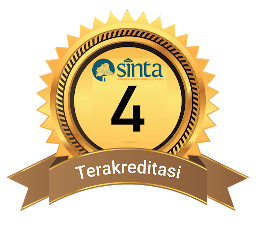Interactive Chemistry Teaching Material Based on Augmented Reality Technology In Covalent Bonding Submaterial
DOI:
10.29303/cep.v4i1.2441Published:
2021-05-29Issue:
Vol. 4 No. 1 (2021): Edisi MeiArticles
Downloads
Additional Files
How to Cite
Abstract
This study aimed to obtain the feasibility of interactive teaching materials based on augmented reality technology in covalent bonding in terms of validity, practicality, and effectiveness. The research design uses the 4D model, which is limited to the third stage, namely Define, Design, and Develop. Feasibility is based on validation, practicality, and effectiveness. Based on the validation results on content validation and construct validation, the percentage of 82.66% and 85.55% was obtained as very valid criteria. Practicality was obtained from students' responses and observations with a percentage of 95.5% and 98.61% on practical criteria. Effectiveness is obtained from learning outcomes with the acquisition of N-Gain 0.75 in the high category and paired t-test with a sign of 0.000 <0.05 so that there is a significant difference between the pretest score and the posttest score. The results of students' motivation obtained a percentage of 79.34% in the effective category. It proves that the teaching material is suitable for use as a learning medium. In the future, it is hoped that this augmented reality technology can be further developed in other chemical materials so that it can make learning more interactive.
Keyword: Augmented Reality, Covalent Bonding, Teaching Material.
References
Andayani, Y., Junaidi, E., 2018. Hubungan Kesiapan Teknologi Informasi Dan Komunikasi (Tik) Dengan Motivasi Belajar Kimia Siswa. Chem. Educ. Pract. J. 2, 6. https://doi.org/10.29303/cep.v2i2. 1414
Effendy, 2013. Teori VSEPR, Kepolaran, dan Gaya Antar Molekul, Edisi 3, 3rd ed. Bayumedia, Malang.
Hake, R.R., 1999. Analyzing Change/Gain Scores.
Ibrahim, M., 2014. Model Pengembangan Perangkat Pembelajaran Menurut Jerold E. Kemp & Thiagarajan. PSMS-PPs Unesa, Surabaya.
Ilyasa, D.G., 2020. Model Multimedia Interaktif Berbasis Unity Untuk Meningkatkan Hasil Belajar Ikatan Ion. J. Inov. Pendidik. Kim. 14, 2572ââ¬â2584.
Kamelia, L., 2015. Perkebangan Teknologi Augmented Reality Sebagai Media Pembelajaran Interaktif Pada Mata Kuliah Kimia Dasar IX, 16.
Lutï¬Â, A., 2013. Memotivasi Siswa Belajar Sains Dengan Menerapkan Media Pembelajaran Komik Bilingual. J. Pendidik. Dan Pembelajaran 20, 152ââ¬â159.
Nopihargu, A., 2014. Implementasi Strategi Pembelajaran Intertekstual Pada Materi Reaksi Redoks Kelas X. J. Univ. Pendidik. Indones.
Plomp, T., Nieveen, N., 2010. Educational Education Research. SLO, Netherlands.
Prastowo, A., 2012. Creative Guide Creating Innovative Instructional Materials. Diva Press, Yogyakarta.
Riduwan, 2015. Dasar-Dasar Statistika. Alfabeta, Bandung.
Rifaââ¬â¢i, M., Listyorini, T., Latubessy, A., 2014. Penerapan Teknologi Augmented Reality Pada Aplikasi Katalog Rumah Berbasis Android. Pros. SNATIF 1, 267ââ¬â24.
Sandi, G., 2012. Pengaruh Blended Learning Terhadap Hasil Belajar Kimia Ditinjau Dari Kemandirian Siswa 45, 241ââ¬â251.
Sirakaya, M., Cakmak, E.K., 2018. The Effect of Augmented Reality Use on Achievement, Misconception and Course Engagement. Contemp. Educ. Technol. 9. https://doi. org/10.30935/cet.444119
Widarti, H.R., Safitri, A.F., Sukarianingsih, D., 2018. Identiikasi Pemahaman Konsep Ikatan Kimia. J-PEK J. Pembelajaran Kim. 3, 41ââ¬â50. https://doi.org/10.17977/ um026v3i12018p041
Yuliono, T., Sarwanto, S., Rintayati, P., 2018. Keefektifan Media Pembelajaran Augmented Reality Terhadap Penguasaan Konsep Sistem Pencernaan Manusia. J. Pendidik. Dasar 9, 65ââ¬â84. https://doi.org /10.21009/10.21009/JPD.081
Author Biographies
Aflah Farchan Rizqullah, Universitas Negeri Surabaya
Achmad Lutfi, Universitas Negeri Surabaya
License
Authors who publish with Chemistry Education Practice agree to the following terms:
- Authors retain copyright and grant the journal right of first publication with the work simultaneously licensed under a Creative Commons Attribution License 4.0 International License (CC-BY-SA License). This license allows authors to use all articles, data sets, graphics, and appendices in data mining applications, search engines, web sites, blogs, and other platforms by providing an appropriate reference. The journal allows the author(s) to hold the copyright without restrictions and will retain publishing rights without restrictions.
- Authors are able to enter into separate, additional contractual arrangements for the non-exclusive distribution of the journal's published version of the work (e.g., post it to an institutional repository or publish it in a book), with an acknowledgement of its initial publication in Chemistry Education Practice.
- Authors are permitted and encouraged to post their work online (e.g., in institutional repositories or on their website) prior to and during the submission process, as it can lead to productive exchanges, as well as earlier and greater citation of published work (See The Effect of Open Access).






